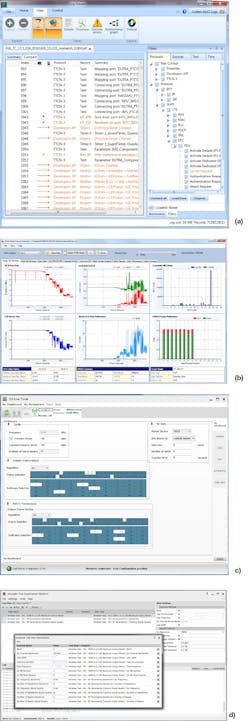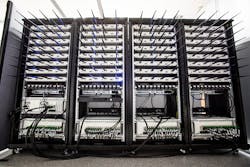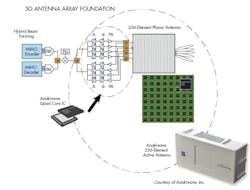Download this article as a .PDF
5G is big. Also known as 5G New Radio (NR), this new wireless technology will ultimately impact everyone in the electronics and telecommunications industries, not to mention the effect that it will have on us individually. 5G NR has been under development now for several years, and while progress is being made to finalize the standard, it is still years away before becoming what we call mainstream. Most estimates say 2020 is when we will ultimately see some real 5G deployments on a scale that will we will notice. In the meantime, companies are firming up their plans for whatever 5G products and services they will offer. Considerable hype still abounds, but real progress is being made. Here is a fresh assessment of 5G status.
What’s the Hurry? LTE is Great
Do we really need 5G right now? Our current 4G cellular standard Long Term Evolution (LTE) is adequately serving most of us right now. Are conditions so bad that we are anxious for the next generation to come along and relieve our suffering? I don’t think so. Virtually all cellular carriers now implement LTE that is delivering megabit speeds over most of the developed world.
In addition, the carriers are regularly updating their systems to add capacity or boost data rates. Many have already implemented LTE Advanced and are on the path to LTE Advanced Pro. These advanced versions offer features like carrier aggregation (CA) that combines up to five 20 MHz channels, increased MIMO configurations to 8×8, and modulation to 256QAM. These provide the potential for gigabit speed, although in reality hundreds of megabits downloads are more likely. Isn’t that enough? For some, probably not. Yet it is fine for the average masses. Video hogs always want more.
LTE is also now serving the need for some Internet of Things (IoT) applications. Yes, cellular is an option. The new LTE M1 and NB-IoT versions are being embedded into products. Most major carriers offer IoT or machine-to-machine (M2M) services that are typically manageable on existing networks. That application is growing.
Never satisfied, the industry is pushing ahead for something better. Isn’t that what we always do? Once a technology standard like LTE is finalized and commercially implemented we typically rush to top it with a new and better standard. It keeps us busy and challenged and pushes us to develop better hardware and software. How do engineers stay interested if they are not brainstorming then designing the next chips, products, and programs? We invent stuff even if we don’t need it, because revenue growth is a perpetual need.
LTE is more than satisfactory for now, and it will continue. 5G will not replace LTE.—it will serve a separate need and will complement LTE. Some call 5G an LTE overlay. You will not be wanting for good cellular service.
The 5G Rationale
Those pushing for 5G cite two major needs. First, everyone wants faster mobile broadband services on our smartphones and tablets. The key driving force is video. Audio is another major application. More cord-cutting and streaming. 4K and even 8K high definition video content is now available. We have become a nation of watchers and listeners, not readers. The smartphone makers are giving us bigger and higher resolution screens and faster processors to deal with our video-intensified life. The cellular operators are continually gearing up to provide the major pipeline for this coming video/audio glut.
Then there is the looming Internet of Things threat. We are already experiencing a significant increase in IoT connectivity, but more is coming. The predictions says billions more devices will ultimately need connections, and the cellular folks want a piece of that IoT and M2M business. LTE is dealing with it now, but 5G will greatly expand the potential uses.
For example, 5G will offer increased capacity and decreased latency for some critical applications such as vehicle-to-vehicle (V2V) or vehicle-to-infrastructure (V2I) communications for advanced driver assistance systems (ADAS) and self-driving vehicles. A 5G-based cellular V2X communications system could very will replace the long-approved DSRC radios that use the 802.11p Wi-Fi-like standard.
Cellular operators are also looking at the broadband wireless market to deliver high-speed internet service. 5G will allow carriers to offer fast internet service in competition with cable and fiber ISPs. With 5G, wireless speeds will be on par with those hard-wired services, giving them a new revenue stream.
No, we are not desperate for 5G, as LTE is adequate for now. But we will love 5G once it gets here.
Defining 5G
The 5G standard is not complete as this is written, but we do know some generalities. The overall goals are a user capacity of x100 over existing LTE capability, downlink data rates up to 10 Gb/s, and a latency of less than 10 ms. Here are the highlights of the proposed 5G standard to meet these goals.
- A variety of spectrum will be used. Much of it will be below 6 GHz. Each carrier has its own spectrum licenses that vary widely. For example, T-Mobile bought some 600 MHz spectrum for 5G use. T-Mobile can also use some existing 1.7 and 2.1 GHz space. Sprint will use its extensive 2.5 GHz spectrum holdings. The 3.5 GHz Citizens Broadband Radio Service (CBRS) now used by the military may see some 5G usage on a shared basis. But the major trend is to move to the millimeter wave bands to gain more bandwidth to support that gigabit speed target. In the U.S. the 28 GHz and 39 GHz bands will be the new operational space. AT&T, T-Mobile, and Verizon have committed to this spectrum. This new spectrum provides the much wanted bandwidth up to 1 GHz. However, these frequencies offer new challenges of radio wave propagation and wireless circuitry. This industry as a whole is stepping up to make the mmWave bands workable.
- A dense collection of small cells will supplement traditional basestations. These miniature cell sites will attach to light poles, the sides of buildings, and on other structures to get the height needed for reliable connectivity. Getting permissions to install the small cells is turning out to be a major problem and will no doubt slow implementation of full 5G networks. Providing power and backhaul are related issues. While fiber backhaul is preferred for its speed, it is more costly to install, making microwave or mmWave backhaul a better choice for many installations. Otherwise, the dense small cell strategy is sound and will complement the existing LTE cell sites. Combined these sites should provide the coverage needed to make our 5G dreams come true.
- The modulation will surely be some form of OFDMA, different from plain old LTE. The final variant has yet to be revealed. Also look for some other features like different OFDMA subcarrier bandwidths up from LTE’s 15 kHz to 30, 60, 75, 120, or 240 kHz.
- Adaptive modulation to 256QAM will be adopted.
- Time division duplexing (TDD) replaces frequency division duplexing (FDD) that requires twice the spectrum.
- New channel coding includes low density parity check (LDPC) for data and polar coding for control.
- Massive, multiuser MIMO and antenna agile beamforming will be a standard feature.
- Some carriers like Verizon will offer their own technical variant of 5G.
Be Thankful for the T&M Companies
Let’s all show our appreciation for the test-and-measurement companies that literally make it possible to create 5G. Without the ability to simulate and test new hardware and software, the 5G developers would be stalled or limited. We would not be nearly as far along in 5G development without frequency-related arbitrary signal generators, spectrum analyzers, vector signal analyzers, vector network analyzers, and oscilloscopes. The T&M companies are the real pioneers of 5G and their products make it possible for the rest of the developers to create, test, evaluate, and make final standards decisions. Some of the key challenges of 5G testing include the still-unknown version of the OFDM modulation, massive MIMO, channel simulation and estimation, and the clear need for extensive over the air (OTA) testing. Here are just a few of the many products that companies are offering to expedite the way to 5G.
Keysight Technologies’ contribution to the 5G test effort is its 5G RF DVT Toolset, an addition to the company’s network emulation solution (NES) portfolio. The Toolset is based upon Keysight’s UXM 5G wireless test platform. Its purpose is to ensure measurement traceability from prototyping to acceptance and manufacturing. The DVT Toolset software uses Keysight’s Test Automation Platform (TAP) to generate RF and radio resource management test cases. It is applicable to 5G NR, including mmWave frequencies and beamforming. Figure 1 shows some example uses.
1. Screenshots from Keysight’s 5G DVT Toolbox software show applications: (a) Customizable filters allow different teams to investigate issues efficiently; (b) Key Performance Indicators (KPI) statistics ensure cost-effective development; (c) Real-time access to L1/L2 protocol parameters accelerate test programs; and (d) TAP (Test Automation Platform) allows the user to easily create and customize RF and RRM test cases with the highest degree of parametrization.
National Instruments is offering its line of 28 GHz radio heads that make it easy to experiment with and test 5G systems. These software-defined transceivers cover the 27.5 to 29.5 GHz range and can accommodate signals up to 2 GHz wide (Fig. 2).
2. National Instruments’ MillimeterWave Transceiver System (MTS) facilitates radio development in the 28 GHz band.
Figure 3 shows how National Instruments test systems permit the evaluation of massive MIMO. This 128-antenna MIMO system was developed and tested by the University of Bristol in the UK for British Telecom.
3. This is how National Instruments meets the challenge of testing massive MIMO systems.
Rohde & Schwarz helps to solve the 5G signal generation problem with its SMW200A vector signal generator. It produces signals up to 40 GHz and permits a bandwidth up to 2 GHz. It supports to 8× carrier aggregation. A companion instrument is the FSW spectrum and signal analyzer.
The Technology that Makes It Possible
Chips that operate at the millimeter wave bands are making 5G possible. Some examples are chips from some major vendors
Analog Devices’ AD9371 dual RF transceiver is one chip that is making it easier to make phased arrays with beamforming. This device includes two transmitters and two receivers that operate at frequencies up to 6 GHz (Fig. 4). It supports FDD and TDD operation. When combined with the phase shifters and amplifiers, this transceiver provides most of the circuitry to build large MIMO and beamforming phased arrays.
Analog Devices’ AD9371 dual transceiver operates up to 6 GHz and is finding a home is some 5G products.
Qualcomm is a leader in supplying modems and radio chips to smartphone makers. Its latest modem is the Snapdragon X50 for 5G. It works in the 28 GHz band and can connect using up to 800 MHz of bandwidth. It supports download speeds to 5 Gb/s. It also incorporates MIMO and antenna techniques like adaptive beamforming and beam tracking. The X50 can pair with a Snapdragon processor with an integrated LTE modem to provide a complete 4G/5G solution for smartphones.
Chip companies like Qorvo and Skyworks are pushing their GaN and GaAs technologies to the limit to make mmWave power amplifiers (PAs), low noise amplifiers (LNAs), switches, and other components.
But when you dig a little deeper, you will discover that the technology that really brings it all home involves antennas. The unappreciated component of wireless products is the antenna, more of a mechanical device than an electronic device. It is actually both, as it is a transducer with full transmit-receive reciprocity. A new generation of antennas is being created to deal with the higher operating frequencies, limited spectrum space, and need for higher speeds.
Most new 5G gear will incorporate antenna technology like multiple input multiple output (MIMO), including massive multiuser MIMO that will boost signal reliability as well as raise the data rate. Then there are the phased arrays that give us adaptive beamforming and high gain needed to propagate the mmWave signals over a practical distance with minimal interference to other users or cell sites. At mmWave frequencies, these multiple element antennas are small enough to use on the smallest basestations, as well as in our smartphones.
An example of a product that is making these antennas possible is the Anokiwave AWA-0134 that is used to implement a phased array with 256 radiating elements. (Fig. 5). This antenna allows 4×4 MIMO operation with beamforming. The system uses 64 Anokiwave chips, each serving four antenna elements.
5. The Anokiwave AWA-0134 contains PAs, LNAs, phase shifters, attenuators, and switches that simplify phased array construction to meet MIMO and beamforming requirements.
While MIMO and phased arrays are the solution to meeting 5G specifications, the antenna is ultimate challenge for handset designers. Smartphone engineers have continued to address the need for multiple antennas. The average smartphone has two main cellular radio antennas, plus antennas for Wi-Fi, Bluetooth, and GNSS/GPS. The question is how to add more antennas for MIMO needs as well as the 5G mmWave band antennas? A considerable amount of engineering is now in progress to solve this problem. Custom antennas that fit the packaging needs of the smartphones will no doubt be the solution.
The 5G Timeline
The Third Generation Partnership Project (3GPP) does its development work in stages and periodically introduces segments of the standards in documents called Releases. The 3GPP offers a projected time line but it regularly changes as the work progresses. On top of that, the industry is pushing for more detail sooner so chip, equipment, and software development can get on with it.
The latest word is that a complete 5G proposal will be submitted for review in the first quarter of 2018. We should see the first version Release 15 about that time. Ultimately, the long estimated final standard (Release 16) availability in the late-2019 to mid-2020 timeframe seems likely. Yet we are seeing lots of parallel development of hardware and software along with many field trials.
Aside from a few scattered initial installations around the world in the 2018 to 2019 period, the first real working deployments will probably be after 2020. Wireless internet access services are expected to be the first real application. It may take the smartphone manufacturers a while longer to figure out how to put 5G in a handset along with LTE and other backward-compatible features.
Go and enjoy your new iPhone X or iPhone 8 and prepare for the next LTE-A Pro iPhone 11. 5G probably won’t show up until the iPhone 12. Perhaps it will be the iPhone 20/20 (or XX/XX). For now, learn to appreciate the LTE that serves us so well. Until the 5G formal introduction, watch the progress on the 3GPP website.
About the Author
Lou Frenzel
Technical Contributing Editor
Lou Frenzel is the Communications Technology Editor for Electronic Design Magazine where he writes articles, columns, blogs, technology reports, and online material on the wireless, communications and networking sectors. Lou has been with the magazine since 2005 and is also editor for Mobile Dev & Design online magazine.
Formerly, Lou was professor and department head at Austin Community College where he taught electronics for 5 years and occasionally teaches an Adjunct Professor. Lou has 25+ years experience in the electronics industry. He held VP positions at Heathkit and McGraw Hill. He holds a bachelor’s degree from the University of Houston and a master’s degree from the University of Maryland. He is author of 20 books on computer and electronic subjects.
Lou Frenzel was born in Galveston, Texas and currently lives with his wife Joan in Austin, Texas. He is a long-time amateur radio operator (W5LEF).






